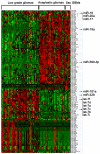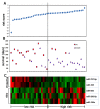MicroRNA expression patterns in the malignant progression of gliomas and a 5-microRNA signature for prognosis
- PMID: 25415048
- PMCID: PMC4350338
- DOI: 10.18632/oncotarget.2679
MicroRNA expression patterns in the malignant progression of gliomas and a 5-microRNA signature for prognosis
Abstract
MicroRNAs (miRNAs) are directly involved in the progression in various cancers. To date, no systematic researches have been performed on the expression pattern of miRNA during progression from low grade gliomas to anaplastic gliomas or secondary glioblastomas and those prognostic miRNAs in anaplastic gliomas and secondary glioblastomas. In the present study, high-throughput microarrays were used to measure miRNA expression levels in 116 samples in the different progression stages of glioma. We found that miRNA expression pattern totally altered when low grade gliomas progressed to anaplastic gliomas or secondary glioblastomas. However, anaplastic gliomas and secondary glioblastomas have similar expression pattern in miRNA level. Furthermore, we developed a five-miRNA signature (two protective miRNAs-miR-767-5p, miR-105; three risky miRNAs: miR-584, miR-296-5p and miR-196a) that could identify patients with a high risk of unfavorable outcome in anaplastic gliomas regardless of histology type. It should be highlighted that the five-miRNA signature can also identify patients who had a high risk of unfavorable outcome in secondary and TCGA Proneural glioblastomas, but not Neural, Classical and Mesenchymal glioblastomas. Taken together, our results demonstrate that miRNA expression patterns in the malignant progression of gliomas and a novel prognostic classifier, the five-miRNA signature, serve as a prognostic marker for patient risk stratification in anaplastic gliomas, Secondary and Proneural glioblastomas.
Conflict of interest statement
None of the authors has any conflict of interest to disclose.
Figures





Similar articles
-
High miR-196a and low miR-367 cooperatively correlate with unfavorable prognosis of high-grade glioma.Int J Clin Exp Pathol. 2015 Jun 1;8(6):6576-88. eCollection 2015. Int J Clin Exp Pathol. 2015. PMID: 26261539 Free PMC article.
-
A 4-miRNA signature to predict survival in glioblastomas.PLoS One. 2017 Nov 14;12(11):e0188090. doi: 10.1371/journal.pone.0188090. eCollection 2017. PLoS One. 2017. PMID: 29136645 Free PMC article.
-
Microarray analysis of the aberrant microRNA expression pattern in gliomas of different grades.Oncol Rep. 2015 Jul;34(1):318-24. doi: 10.3892/or.2015.3953. Epub 2015 May 6. Oncol Rep. 2015. PMID: 25954994
-
Prognostic role of microRNA-21 expression in gliomas: a meta-analysis.J Neurooncol. 2016 Oct;130(1):11-17. doi: 10.1007/s11060-016-2233-7. Epub 2016 Aug 16. J Neurooncol. 2016. PMID: 27531352 Review.
-
miRNAs as important drivers of glioblastomas: a no-brainer?Cancer Biomark. 2012;11(6):245-52. doi: 10.3233/CBM-2012-0271. Cancer Biomark. 2012. PMID: 23248182 Review.
Cited by
-
Disruption of the EZH2/miRNA/β-catenin signaling suppresses aerobic glycolysis in glioma.Oncotarget. 2016 Aug 2;7(31):49450-49458. doi: 10.18632/oncotarget.10370. Oncotarget. 2016. PMID: 27385092 Free PMC article.
-
Role of MicroRNAs in Malignant Glioma.Chin Med J (Engl). 2015 May 5;128(9):1238-44. doi: 10.4103/0366-6999.156141. Chin Med J (Engl). 2015. PMID: 25947409 Free PMC article. Review.
-
MicroRNA induction by copy number gain is associated with poor outcome in squamous cell carcinoma of the lung.Sci Rep. 2018 Oct 18;8(1):15363. doi: 10.1038/s41598-018-33696-1. Sci Rep. 2018. PMID: 30337605 Free PMC article.
-
CircRNA circ_0000190 inhibits the progression of multiple myeloma through modulating miR-767-5p/MAPK4 pathway.J Exp Clin Cancer Res. 2019 Feb 6;38(1):54. doi: 10.1186/s13046-019-1071-9. J Exp Clin Cancer Res. 2019. PMID: 30728056 Free PMC article.
-
Four-miRNA signature as a prognostic tool for lung adenocarcinoma.Onco Targets Ther. 2017 Dec 21;11:29-36. doi: 10.2147/OTT.S155016. eCollection 2018. Onco Targets Ther. 2017. PMID: 29317831 Free PMC article.
References
-
- Schickel R, Boyerinas B, Park SM, Peter ME. MicroRNAs: key players in the immune system, differentiation, tumorigenesis and cell death. Oncogene. 2008;27(45):5959–5974. - PubMed
-
- Lee HK, Finniss S, Cazacu S, Bucris E, Ziv-Av A, Xiang C, Bobbitt K, Rempel SA, Hasselbach L, Mikkelsen T, Slavin S, Brodie C. Mesenchymal stem cells deliver synthetic microRNA mimics to glioma cells and glioma stem cells and inhibit their cell migration and self-renewal. Oncotarget. 2013;4(2):346–361. - PMC - PubMed
-
- Calin GA, Croce CM. MicroRNAs and chromosomal abnormalities in cancer cells. Oncogene. 2006;25(46):6202–6210. - PubMed
Publication types
MeSH terms
Substances
LinkOut - more resources
Full Text Sources
Other Literature Sources
Medical

